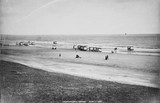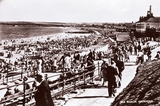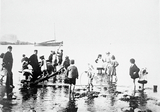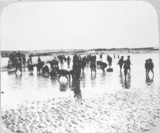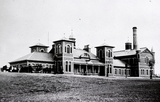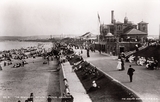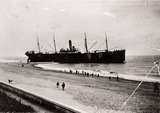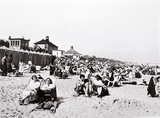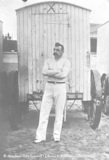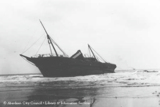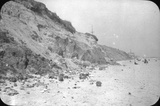|
Quick Search
|
Search Results
You searched for: Subject matches "Aberdeen Beach" or its children
91 items
items as
Aberdeen Beach
45 A George Washington Wilson photograph (no. 4045) showing Aberdeen beach in the late 19th century.
Bathing machines (also called bathings huts) can be seen at the water's edge. These were drawn to and from the sea by horses, as can be seen in the image.
There were about 30 machines on the beach at any one time and male and female bathing areas were segregated.
In 1933 the horses were retired and the machines served as static changing huts until 1954. They were then kept in storage and later offered for public sale as mementos of a bygone bathing era. Aberdeen Sea Beach
51 The Promenade at Aberdeen Sea Beach, c. 1950 with the Beach Shelter and Beach Bathing Station in the background. Beach Bathing Station
99 The interior of the Beach Bathing Station, where generations of Aberdonians learnt to swim in the fresh water pool. The Bathing Station was designed by City Architect, John Rust, and opened on 13th July 1898. A distinctive red brick chimney dominated the beach skyline. The Bathing Station was eventually filled in and demolished, the door having finally closed to the public on 11th July 1972. Aberdeen Beach and Bathing Station
189 Aberdeen Beach and Bathing Station. The Beach Bathing Station where generations of Aberdonians learnt to swim in the fresh water pool. The Bathing Station was designed by City Architect John Rust and opened on 13 July 1898. A distinctive red brick chimney dominated the beach skyline. The Bathing Station was eventually filled in and demolished, the door having finally closed to the public on the 11th July 1972. Children paddling at the beach
263 Portrait of children paddling at the beach. Note the boy with a hoop, centre of photograph. 'The Queen', Aberdeen Beach, 1883
340 The coal ladden schooner, 'The Queen' driven ashore on Aberdeen Beach in March 1883, during a terrible gale. It was unable to make the crossing of the bar at the entrance to the harbour and a number of the crew, frozen and stiff with cold, were blown off the rigging and drowned in the night. Children catching shrimps at Aberdeen Sea Beach
341 Children catching shrimps at Aberdeen Sea Beach. Aberdeen Bathing Station
356 The Beach Bathing Station opened on 13th July 1898, replacing an earlier bathing establishment. This image shows the western, landward, side of the Victorian red brick building with its prominent chimney stack that stood 70 feet high.
At the time of opening the pool was described as the largest in Scotland. It measured 90 feet by 35 feet and 3 to 7 feet in depth. The pool was salt water up until 1958 before changing to freshwater.
Facilities included a water chute, a 9 foot diving board and a spring board at pool level.
Despite a renovation in 1964 its gradual deteriorating condition and decline in use led to its closure in July 1972 and the building was subsequently demolished. The Pleasure Park, Aberdeen Beach
397 A postcard showing John Henry Iles' Pleasure Park in the 1930s. The park's esplanade site, south of Wellington Street (roughly where Amadeus nightclub/the Range and part of the Queen's Links carpark would later stand), was leased to Iles by the Council in 1929. Illes was an amusement entrepreneur originally from Manchester.
The park's biggest attraction, in all senses, was the Scenic Railway roller coaster shown here. Iles was involved in several amusement parks around Britain and during a visit to New York he obtained the European rights to the design of the latest roller coasters. He subsequently erected his Scenic Railway in Aberdeen in 1929.
The roller coaster rose to 100 feet in the air at its highest point and was popular with holiday makers and locals throughout the 1930s. The local press recorded 21,000 children, between 3 and 14 years of age, carried on the ride during a special children's day that was held on Saturday 20th August 1932.
Part of the message written on the back of this postcard by a young visitor to Aberdeen reads "This picture shows you the scenic railway which I have been on and liked very much".
The Scenic Railway was sadly badly damaged by fire on the night of 5th December 1940 and was consequently demolished. Other attractions of Iles' park included rides such as The Caterpillar, The Whip, Water Dodgems, and the Brooklyn Racers (petrol driven cars).
In the background of this image be seen the tower of St. Clements Church and a row of tenements, likely those on Wellington Street. Aberdeen Beach with the Beach Baths
404 An Adelphi Series postcard showing Aberdeen Beach with the Beach Baths building on the right.
Also known as the Beach Bathing Station, its fresh water pool was where generations of Aberdonians learnt to swim.
The Bathing Station was designed by City Architect John Rust and opened on 13 July 1898.
Its distinctive red brick chimney dominated the beach skyline.
The Bathing Station was eventually filled in and demolished, the door having finally closed to the public on the 11th July 1972. Aberdeen Beach from the south
406 Aberdeen Beach from the south. A crowded day on the beach. Note the roof of the Beach Ballrooom at the right of the photograph. Shipwreck of the Idaho
603 Ellerman Steamer the Idaho ran ashore on Aberdeen beach on the 16th January 1929. Arriving in dense fog the ship missed the entrance to the harbour. In July of that year it was re-floated, repaired at the pontoon dock and berthed at Blaikie's Quay. On the 19th September the Idaho left Aberdeen towed by two steam tugs for the Clyde where it was to be dismantled and broken up.
In March of 1929 Rev. James F. Kellas of Mannofield Parish Church delivered a sermon entitled "The stranded steamer and the stranded life - a comparison and an allegory."
The Aberdeen Journal described the aftermath of the wreck as "weird in the extreme". The article continues: "The hazy gleam of the moon cast a cold radiance over the deserted wastes of snow-mantled sands, while across a dark strip of water loomed the black hull of the vessel. A biting wind blew from the north-east. No movement could be seen aboard the steamer, but red lights showed from her mastheads." The Pleasure Park
828 The Pleasure Park at Aberdeen Beach. The famous Scenic railway can be seen in the background.
In 1929 the Town Council leased John Henry Iles a piece of ground adjoining the sea front for use as an amusement park. The pleasure park was located on the esplanade south of Wellington Road.
Iles' park included rides such as The Caterpillar, The Whip, Water Dodgems, and the Brooklyn Racers (petrol driven cars).
The greatest innovation, however, was the scenic railway which rose to 100 feet in the air at its highest point.
The local press recorded 21,000 children, between 3 and 14 years of age, carried on the ride on the "Kiddies Day" that was held on Saturday 20th August 1932.
The ride was popular throughout the 1930s. It was badly damaged by fire on the night of 5th December 1940 and was subsequently destroyed.
Note the tower of St. Clements Church and the row of tenements, likely those on Wellington Street, in the background. Children paddling at Aberdeen Beach
836 Children paddling at Aberdeen Beach, with sailing boats in the background.
Sunbathing on Aberdeen Beach
837 The mid-20th century heyday of Aberdeen beach as a tourist destination.
Deck chairs were a popular feature of the beach up until the 1980s. They could be hired from three stations, each containing 1,800 chairs. Those with hoods were particularly in demand on sunny days.
Like the beach's bathing machines before them, the deck chairs were offered for public sale in 1998.
The Beach Shelter, with its clock tower, can also be seen in the background of this image. In addition to sheltering from the wind and rain, it was used as a landmark for reuniting youngsters separated from parents and as a meeting place before nights out at the nearby Beach Ballroom.
The shelter, a well-known landmark, was demolished in 1986. Its distinction clock tower was initially preserved, however, it was later damaged in storage and dismantled. Sandilands: aerial photograph
850 An aerial view of Sandilands Chemical Works looking east towards the sea. This image likely dates from around the mid-20th century.
Some of the houses on Garvock Wynd, the street on the right of this image, have disappeared compared to earlier aerial views. The next street along to the left, with "the Big Hoose" on its corner, is Baltic Street. Miller Street runs along the bottom of the image.
These chemical works began in 1848 when brothers John and George Miller of Paisley leased the land adjacent to gas works that had opened in 1844. Their intention was to process the by-products of coal gas manufacture. The business operated as John Miller & Company, known locally as "stinky Miller's", and went on to manufacture a range of products for North East agriculture.
An obituary for John Miller can be found in the Aberdeen Free Press of 6th March 1894, page 4. An obituary for George Miller featured on page 4 of the Aberdeen Weekly Journal of 11th September 1889.
In around 1928, Miller & Co. became part of Scottish Agricultural Industries (SAI). In the 1930s, the first SAI manager, Mr. Bremner, was appointed and this marked the beginning of the end of the Miller era.
SAI was formed in 1928, part of ICI agricultural division (ICI owned 51%), by combining firms such as J. Miller & Co. in Aberdeen, Milne in Dyce and firms in Carnoustie, Ayr, Edinburgh and Glasgow.
Beyond the chemical works can be seen Queen's Links and the Pleasure Beach across Wellington Street. The esplanade and North Sea are visible beyond. Portrait of sporting young man in white flannels standing in front of a bathing machine.
1648 Correspondent Ed Fowler has been in touch with the following information concerning this image:
"Bathing Machines were temporary changing rooms that were wheeled down to the beach strand. They allowed sea swimmers a ready facility of changing into bathing costumes or out of wet costumes after swimming in the sea.
The facility was spartan - just 2 bench seats - wet and dry sides perhaps and a small round vanity mirror at head level.
They were soon outmoded and removed from the beach and stored behind the Banner Mill for 1940's children, such as the writer, to explore and vandalise.
The well-built gentleman in this photograph was likely a self-appointed lifeguard of the era and maybe Scotland's champion swimmer and diver - Aberdeen's Mr Willie 'Moosie' Sutherland.
He was famed for his rescue successes at Aberdeen Beach, Walkers Dam and the River Dee and was an active member of the Dee Swimming Club and Bon Accord Club since 1865.
'Moosie' saved well over 100 Lives and was given a recognition of Rescue service award by Lord Provost Leslie in 1871 at the age of 27 years.
He died aged 42 on the 20th September 1886 his last competitive race was the first ever Dee to Don Estuaries swim in the same year." SS James Hall
1937 The wreck of the steamship "James Hall".
On Tuesday 23rd February 1904, the steamer James Hall, belonging to the Aberdeen, Leith and Moray Firth Steam Shipping Company Ltd, and the Luddick, belonging to the Aberdeen, Newcastle and Hull Steam Company Ltd, collided in Aberdeen Bay.
The crew of the James Hall were rescued by the Luddick and the former was left to drift ashore on the beach. The damaged Luddick successfully steamed into harbour.
There was a large hole about 17 feet long in the James Hall, but it was thought possible to temporarily repair the damage and refloat the ship. For the next few days, the local press reported that crowds of people had been to see the wreck, and that two trams with posters saying 'To and from the stranded steamer' were put on the Beach route.
Unfortunately, owing to strong winds and heavy seas, salvage attempts were not possible, and the vessel began to break up and its cargo was washed ashore. By the 8th March, very little remained of the wreck. SS James Hall
1938 The wreck of the steam ship the 'James Hall'. It drifted ashore after colliding with another called the 'Luddick' on 23rd February 1904. The beach north of Footdee
1943 This photograph shows Aberdeen beach north of Footdee. The image is dated as from 1906.
Construction of the beach esplanade began in 1898. The rocky dunes show it had not yet reached this point of Aberdeen's beach front.
In the early 20th century the esplanade only went as far south as slightly beyond the Bathing Station, the chimney of which can be seen in the distance.
The structure protruding above the dunes in the centre of the image may be a flagpole at the gun battery then located on Queen's Links. |



